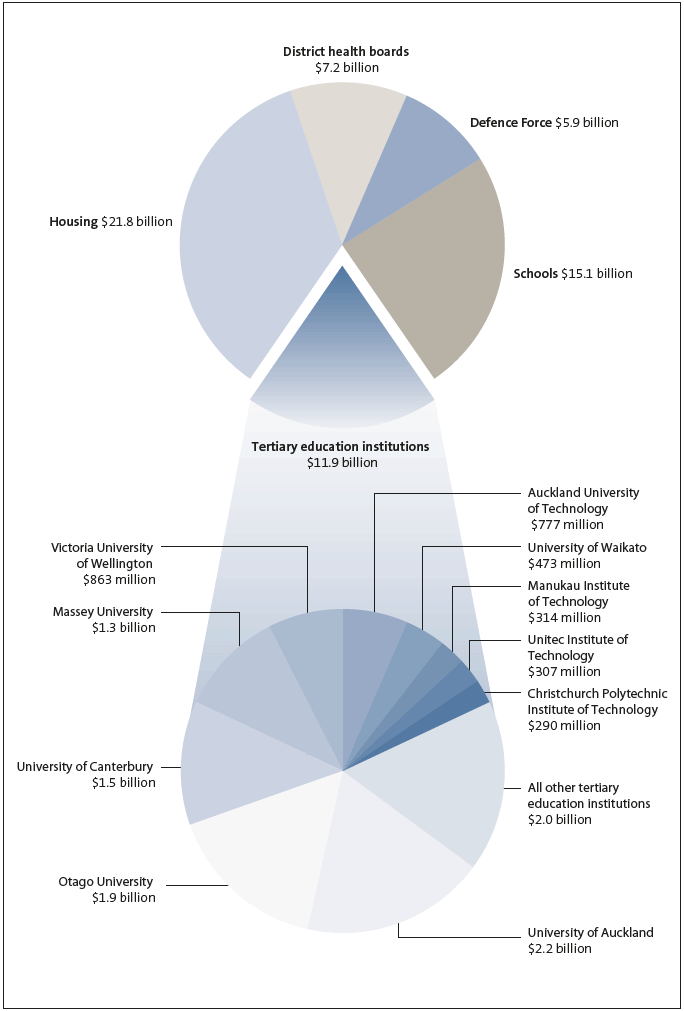Part 1: Introduction
1.1
Tertiary education institutions – our universities, polytechnics, wānanga, and tertiary education organisations – make an important contribution to New Zealand's social and economic success. In 2015, these institutions held about $9.7 billion in net assets, including $9.5 billion in capital assets. In 2014, they also planned to spend a further $8.2 billion on capital assets by 2024.
1.2
Tertiary education institutions receive public money but were set up with a degree of autonomy – they make their own decisions about how best to operate. They are also expected to describe how they will give effect to the Government's strategic direction and policy. Public funding through student enrolments is their main but not their only source of revenue. Changes in student enrolment patterns can significantly affect tertiary education institutions' revenue.
Why we did our audit
1.3
Tertiary education could not occur without assets – they support education and the quality of research and innovation in New Zealand, the Government's business growth agenda, national economic aims, and the health of society.
1.4
Given their importance, we wanted to see whether the investment in those assets was in keeping with the Government's strategy for tertiary education. We also carried out work to see whether we could demonstrate a link between the investment made in tertiary education sector assets and educational outcomes for students.
Value of the assets in tertiary education
1.5
The value of the assets in the tertiary education sector is considerable. Figure 1 compares the tertiary education sector's total assets with those of other sectors (schools, district health boards, housing, and defence) and then shows the tertiary education institutions by asset value.
Figure 1
Total value of assets held by tertiary education institutions and other selected sectors in 2015

Source: The Treasury, Financial Statements of the Government of New Zealand for the Year Ended 30 June 2015, and the annual reports for 2015 of Housing New Zealand, the New Zealand Defence Force, the Ministry of Education, all district health boards, and tertiary education institutions.
1.6
We expected that investment decisions would consider factors that could influence the future development of tertiary education assets, such as:
- demographic changes affecting the domestic student population;
- a competitive international market for students;
- the effects of information technology on teaching and learning; and
- changes in the "network" of tertiary education services delivered regionally and nationally.
1.7
These factors are similar to those identified by the Productivity Commission. The Commission responded to the Government's request "to investigate how trends in technology, internationalisation, population, tuition costs and demand for skills may drive changes in models of tertiary education" by releasing a draft report in September 2016. The Commission intends to provide a final report to the Government on this topic in February 2017.1
1.8
In our work, we wanted to assess whether tertiary education institutions were considering these sorts of factors and the decisions of other tertiary education institutions, and show whether these factors could affect the relationship between the money spent on assets (as measured by the net assets of each tertiary education institution) and educational outcomes for students.
What we looked at
1.9
The tertiary education sector is complex – there are universities, polytechnics, wānanga, private training establishments, the Ministry of Education, the Tertiary Education Commission, the New Zealand Qualifications Authority, the Education Review Office, and other education agencies and tertiary education service providers. There are also many ways to assess effectiveness.
1.10
For this report, we looked at the effectiveness of investments in assets from two perspectives. First, we assessed effectiveness by reviewing a selection of investment business cases prepared by universities and polytechnics (see Appendix 1). We identified the extent to which the universities and polytechnics considered wider factors and the actions of each other in their investment decisions. Secondly, we looked at data for a wider group of 29 tertiary education institutions.2 We developed an "investment effectiveness" ratio to connect the investment in tertiary education assets with measures of educational success.
1.11
Specifically, we:
- assessed 14 business cases held by the Tertiary Education Commission from 11 universities and polytechnics;
- reviewed the most recent organisational strategies and investment plans of those 11 universities and polytechnics;
- considered the investment effectiveness of tertiary education institutions;
- formulated some test scenarios about changing student numbers3 and how those might affect our investment effectiveness measure; and
- discussed the proposed work with some tertiary education institution groups and sought the views of officials from the Ministry of Education, the Tertiary Education Commission, Education New Zealand, the Treasury, and the Productivity Commission on our preliminary findings.
1.12
Appendix 2 lists the types of data we obtained and the methods we used.
Structure of this report
1.13
In the rest of this report:
- Part 2 sets out some of the tertiary education context in which investments in assets are made.
- Part 3 sets out our assessment of 14 business cases from 11 universities and polytechnics.
- Part 4 discusses our analysis of the investment effectiveness of tertiary education institutions.
1: See "New models of tertiary education" in the Inquiries section of the Productivity Commission's website, www.productivity.govt.nz.
2: There were mergers after we started our work, so there are now fewer than 29 tertiary education institutions.
3: In this report, we use the term "student numbers" to mean the same as Equivalent Full-Time Students.

